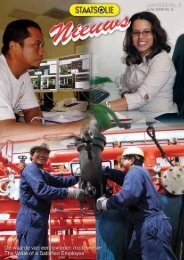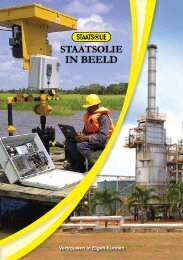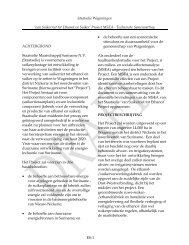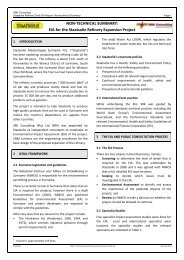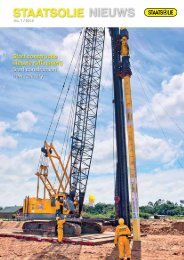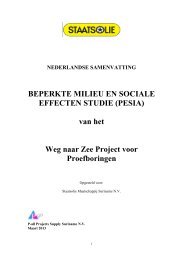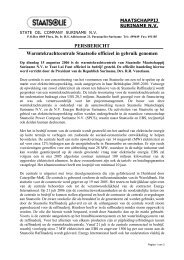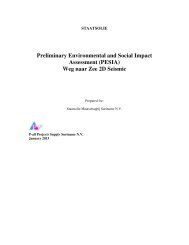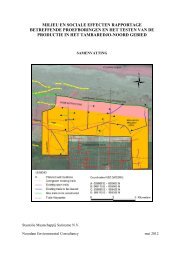(PESIA) Weg naar Zee 2D Seismic - Staatsolie
(PESIA) Weg naar Zee 2D Seismic - Staatsolie
(PESIA) Weg naar Zee 2D Seismic - Staatsolie
You also want an ePaper? Increase the reach of your titles
YUMPU automatically turns print PDFs into web optimized ePapers that Google loves.
P-all consultants <strong>Staatsolie</strong> Maatschappij Suriname N.V.<br />
<strong>PESIA</strong> <strong>Weg</strong> <strong>naar</strong> <strong>Zee</strong> <strong>2D</strong> <strong>Seismic</strong> 2012<br />
Legend of the <strong>Weg</strong> <strong>naar</strong> <strong>Zee</strong> vegetation map<br />
Mapping<br />
unit<br />
Overview of the vegetation types found in the surroundings of the<br />
Paramaribo-Wanica study area<br />
1 Mudflats<br />
Young coastal mangrove forest dominated by Black Mangrove (ST: Parwa;<br />
2<br />
SC: Avicennia germinans)<br />
Closed to open mature coastal mangrove forest dominated by Black<br />
3<br />
Mangrove (ST: Parwa; SC: Avicennia germinans)<br />
Dying coastal forest : Black Mangrove (ST: Parwa; SC: Avicennia<br />
4<br />
germinans)<br />
5 Salt /Brackish water lagoon (ST/SD: Pan)<br />
6 Salt / Brackish water swamp dominated by short grass and ferns<br />
Brackish water swamp dominated by long grass such as Cat Tails (ST:<br />
7<br />
Payagrasi of Langagrasi or Kunsuwiwiri; SC: Typha domingensis)<br />
Thorny vine scrub, dominated by (ST: Brantimaka, SC: Machaerium<br />
8<br />
lunatum)<br />
9 Freshwater swamp with herbaceous vegetation and swamp scrub<br />
Swamp wood dominated by Blood Wood (ST: Watrabebe; SC: Pterocarpus<br />
officinalis), locally swamp wood characterized by Swamp Plumb (SD:<br />
10<br />
Zwamppruim; SN: Chrysobalanus icaco) and Swamp Soursop (ST: Swampusunsaka;<br />
SD: Zwampzuurzak; SC: Annona glabra)<br />
11 Coastal ridge wood on narrow ridges in brackish to fresh water areas<br />
Ridge forest in freshwater areas, usually heavily damaged by former litter<br />
12<br />
fires<br />
C Build up areas, farmland and abandoned fields<br />
Vegetation and peat fires.<br />
ST=Sranan Tongo Name; SC= Scientific Name; SD=Surinamese-Dutch Name<br />
Since early times, during every dry season, many "grass" swamps are burned intentionally, a<br />
common practice to keep such areas accessible for men and to keep them attractive for certain<br />
game species such as deer.<br />
Grass fires may also start unintentionally when in grassy swamp areas the vegetation along<br />
roadsides and/or on polder dams is burned as a form of weed control.<br />
Grass fires may also start when the vegetation of adjacent areas is slashed and burned for<br />
(re)cultivation purposes.<br />
Also campfires may lead to grass fires.<br />
Burning of the vegetation in the study area is a common practice, as a result of the continuous<br />
extension of Paramaribo and the agriculture areas in the more rural sections. Burning is done to<br />
get rid of the woody vegetation, thus lowering the costs of future land reclamation (construction<br />
of drainage canals and fish holes, establishment of agriculture areas and housing projects).<br />
48




